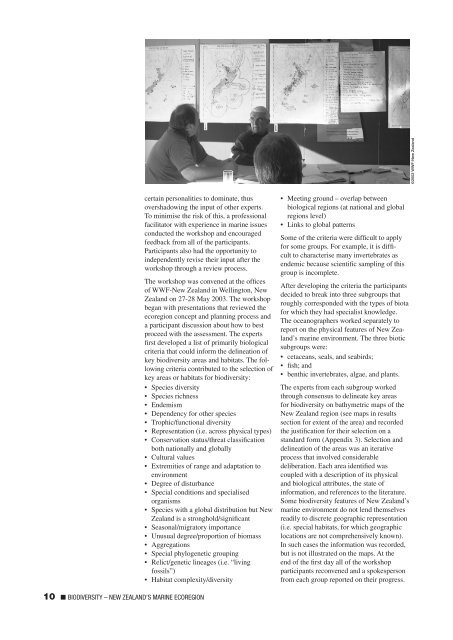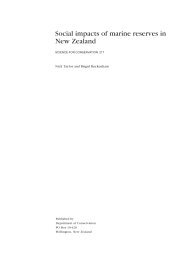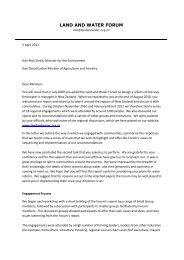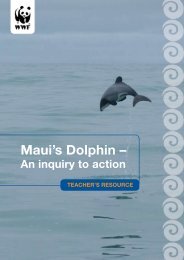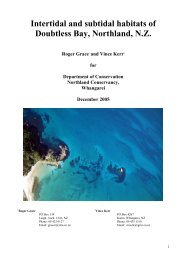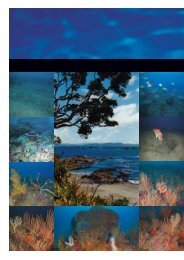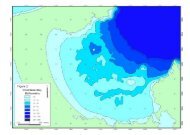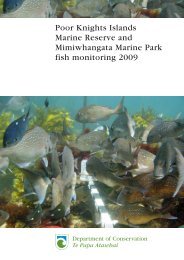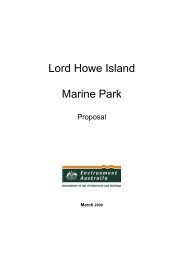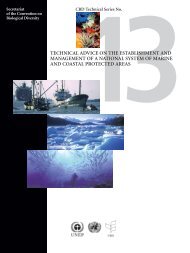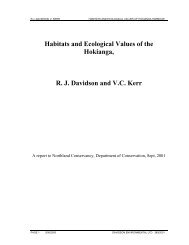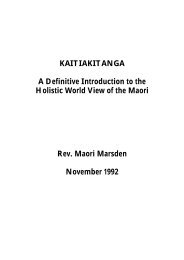WWF Shining a spotlight on the biodiversity of ... - MarineNZ.org.nz
WWF Shining a spotlight on the biodiversity of ... - MarineNZ.org.nz
WWF Shining a spotlight on the biodiversity of ... - MarineNZ.org.nz
You also want an ePaper? Increase the reach of your titles
YUMPU automatically turns print PDFs into web optimized ePapers that Google loves.
©2003 <str<strong>on</strong>g>WWF</str<strong>on</strong>g>-New Zealand<br />
certain pers<strong>on</strong>alities to dominate, thus<br />
overshadowing <strong>the</strong> input <strong>of</strong> o<strong>the</strong>r experts.<br />
To minimise <strong>the</strong> risk <strong>of</strong> this, a pr<strong>of</strong>essi<strong>on</strong>al<br />
facilitator with experience in marine issues<br />
c<strong>on</strong>ducted <strong>the</strong> workshop and encouraged<br />
feedback from all <strong>of</strong> <strong>the</strong> participants.<br />
Participants also had <strong>the</strong> opportunity to<br />
independently revise <strong>the</strong>ir input after <strong>the</strong><br />
workshop through a review process.<br />
The workshop was c<strong>on</strong>vened at <strong>the</strong> <strong>of</strong>fices<br />
<strong>of</strong> <str<strong>on</strong>g>WWF</str<strong>on</strong>g>-New Zealand in Wellingt<strong>on</strong>, New<br />
Zealand <strong>on</strong> 27-28 May 2003. The workshop<br />
began with presentati<strong>on</strong>s that reviewed <strong>the</strong><br />
ecoregi<strong>on</strong> c<strong>on</strong>cept and planning process and<br />
a participant discussi<strong>on</strong> about how to best<br />
proceed with <strong>the</strong> assessment. The experts<br />
first developed a list <strong>of</strong> primarily biological<br />
criteria that could inform <strong>the</strong> delineati<strong>on</strong> <strong>of</strong><br />
key <strong>biodiversity</strong> areas and habitats. The following<br />
criteria c<strong>on</strong>tributed to <strong>the</strong> selecti<strong>on</strong> <strong>of</strong><br />
key areas or habitats for <strong>biodiversity</strong>:<br />
• Species diversity<br />
• Species richness<br />
• Endemism<br />
• Dependency for o<strong>the</strong>r species<br />
• Trophic/functi<strong>on</strong>al diversity<br />
• Representati<strong>on</strong> (i.e. across physical types)<br />
• C<strong>on</strong>servati<strong>on</strong> status/threat classificati<strong>on</strong><br />
both nati<strong>on</strong>ally and globally<br />
• Cultural values<br />
• Extremities <strong>of</strong> range and adaptati<strong>on</strong> to<br />
envir<strong>on</strong>ment<br />
• Degree <strong>of</strong> disturbance<br />
• Special c<strong>on</strong>diti<strong>on</strong>s and specialised<br />
<strong>org</strong>anisms<br />
• Species with a global distributi<strong>on</strong> but New<br />
Zealand is a str<strong>on</strong>ghold/significant<br />
• Seas<strong>on</strong>al/migratory importance<br />
• Unusual degree/proporti<strong>on</strong> <strong>of</strong> biomass<br />
• Aggregati<strong>on</strong>s<br />
• Special phylogenetic grouping<br />
• Relict/genetic lineages (i.e. “living<br />
fossils”)<br />
• Habitat complexity/diversity<br />
• Meeting ground – overlap between<br />
biological regi<strong>on</strong>s (at nati<strong>on</strong>al and global<br />
regi<strong>on</strong>s level)<br />
• Links to global patterns<br />
Some <strong>of</strong> <strong>the</strong> criteria were difficult to apply<br />
for some groups. For example, it is difficult<br />
to characterise many invertebrates as<br />
endemic because scientific sampling <strong>of</strong> this<br />
group is incomplete.<br />
After developing <strong>the</strong> criteria <strong>the</strong> participants<br />
decided to break into three subgroups that<br />
roughly corresp<strong>on</strong>ded with <strong>the</strong> types <strong>of</strong> biota<br />
for which <strong>the</strong>y had specialist knowledge.<br />
The oceanographers worked separately to<br />
report <strong>on</strong> <strong>the</strong> physical features <strong>of</strong> New Zealand’s<br />
marine envir<strong>on</strong>ment. The three biotic<br />
subgroups were:<br />
• cetaceans, seals, and seabirds;<br />
• fish; and<br />
• benthic invertebrates, algae, and plants.<br />
The experts from each subgroup worked<br />
through c<strong>on</strong>sensus to delineate key areas<br />
for <strong>biodiversity</strong> <strong>on</strong> bathymetric maps <strong>of</strong> <strong>the</strong><br />
New Zealand regi<strong>on</strong> (see maps in results<br />
secti<strong>on</strong> for extent <strong>of</strong> <strong>the</strong> area) and recorded<br />
<strong>the</strong> justificati<strong>on</strong> for <strong>the</strong>ir selecti<strong>on</strong> <strong>on</strong> a<br />
standard form (Appendix 3). Selecti<strong>on</strong> and<br />
delineati<strong>on</strong> <strong>of</strong> <strong>the</strong> areas was an iterative<br />
process that involved c<strong>on</strong>siderable<br />
deliberati<strong>on</strong>. Each area identified was<br />
coupled with a descripti<strong>on</strong> <strong>of</strong> its physical<br />
and biological attributes, <strong>the</strong> state <strong>of</strong><br />
informati<strong>on</strong>, and references to <strong>the</strong> literature.<br />
Some <strong>biodiversity</strong> features <strong>of</strong> New Zealand’s<br />
marine envir<strong>on</strong>ment do not lend <strong>the</strong>mselves<br />
readily to discrete geographic representati<strong>on</strong><br />
(i.e. special habitats, for which geographic<br />
locati<strong>on</strong>s are not comprehensively known).<br />
In such cases <strong>the</strong> informati<strong>on</strong> was recorded,<br />
but is not illustrated <strong>on</strong> <strong>the</strong> maps. At <strong>the</strong><br />
end <strong>of</strong> <strong>the</strong> first day all <strong>of</strong> <strong>the</strong> workshop<br />
participants rec<strong>on</strong>vened and a spokespers<strong>on</strong><br />
from each group reported <strong>on</strong> <strong>the</strong>ir progress.<br />
10 ■ BIODIVERSITY – NEW ZEALAND’S MARINE ECOREGION


